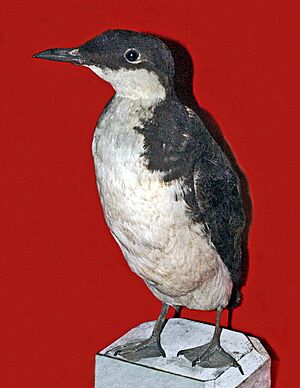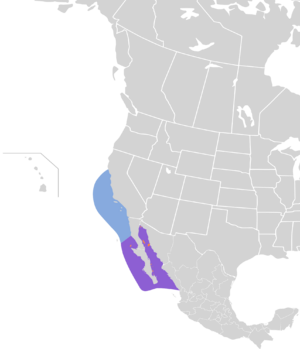Craveri's murrelet facts for kids
Quick facts for kids Craveri's murrelet |
|
|---|---|
 |
|
| Conservation status | |
| Scientific classification | |
| Genus: |
Synthliboramphus
|
| Species: |
craveri
|
 |
|
The Craveri's murrelet (scientific name: Synthliboramphus craveri) is a small seabird. It makes its home on islands far from the coast. These islands are found in the Pacific Ocean and the Gulf of California, near Mexico's Baja peninsula. Sometimes, these birds travel north to central California in the United States.
Sadly, the Craveri's murrelet faces many dangers. Animals brought to their islands, like rats and feral cats, can harm them. Oil spills and busy shipping lanes also pose a big threat. More tourism and fishing boats can also make life harder for them. Experts believe there are about 6,000 to 10,000 breeding pairs left. Because of these threats, the Craveri's murrelet is considered a vulnerable species.
Contents
What Does It Look Like?
The Craveri's murrelet is a small bird with black and white feathers. It has a small head and a thin, sharp beak. This bird looks a lot like its close relative, the Scripps's murrelet. Both are special because they live further south than any other type of auk.
You can tell a Craveri's murrelet apart by a few things:
- It has a partial collar around its neck. The Scripps's murrelet does not.
- Its underwings are dusky, or darkish. The Scripps's murrelet has white underwings.
- The black feathers on its face dip down a bit further than on the Scripps's murrelet.
- You can also tell them apart by the sounds they make!
How Does It Live?
Craveri's murrelets hunt for food far out at sea. They love to eat small fish, like young herring, rockfish, and lanternfish. Like all auks, they are amazing underwater swimmers. They use their strong wings to "fly" through the water, chasing after their prey. They are also good at flying in the air and can take off quickly.
Nesting and Chicks
These murrelets build their nests in small cracks, caves, or under thick bushes. They choose dry islands and live in spread-out groups. They only come back to their nests at night. The female bird lays two eggs, and both parents take turns keeping them warm for about a month.
What's really cool is how fast their chicks grow! Just one or two days after hatching, the tiny chicks leave the nest. They run quickly towards the sea, where their parents call to them. Once they reach the ocean, the whole family swims out to deeper waters. It's hard for scientists to study them once they are at sea, so we don't know much about their lives there.
What Dangers Does It Face?
Many people believe the Craveri's murrelet is one of the most endangered types of auk.
- Oil and Shipping: Oil drilling and large ships carrying oil are a big danger. Oil spills can harm or kill many birds.
- Human Activity: More tourist resorts and fishing boats also cause problems. Birds can get caught in fishing nets.
- Introduced Animals: Animals like mice, rats, and feral cats that were brought to the islands can attack the murrelets. Luckily, people are working hard to remove these animals from the islands to protect the birds.
Where Did Its Name Come From?
This bird was named after two brothers, Federico Craveri and Ettore Craveri. A scientist named Tommaso Salvadori named the bird in their honor in 1866. The Craveri brothers had given many bird species from Mexico and California to the Turin Museum of Natural History.


